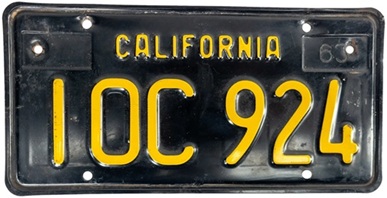

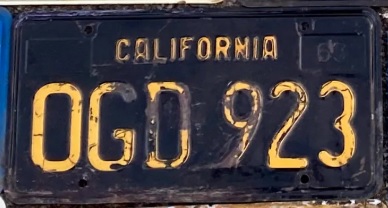
License plates issued during this era had raised yellow text on a black background. "CALIFORNIA" was in smaller raised yellow text at the top, in characters that looked like block printing. The letters were wider than the numeric digits, leaving enough room for a total of 6 characters plus one half-space.
Nearly all of these plates were made of steel. If you press a refrigerator magnet up against one of them, it will stick to it. In their last year of issue (1969) a few of the final black plates made were composed of aluminum.
In 1963, all vehicles that had the previous yellow plates were issued a new black plate. New vehicles were also, of course, issued these black plates. Black plates had the number "63" stamped into the well on the upper-right. (This stamp was merely a pair of dents in the shape of the digits 6 and 3. There was no paint to make them stand out.) This "63" persisted late into the Black Plate era, but by the end some plates issued had no stamp in the upper-right well. Some have speculated that this may have happened because the "63" on the plate-stamping dies had gotten worn down from use. The first year validation sticker was required to be placed in the upper-right well, over the stamped "63". Subsequent year's validation stickers were supposed to alternate between being placed in the upper-left well and the upper-right well.
The letters O and Q on the earliest black plates were shaped like a rounded rectangle. Later plates changed the shape of the O and Q to be true ovals, with completely rounded tops and bottoms. Ironically, this change made them even harder to distinguish from the number 0, which has always been an oval. From online images, I used to think the transition from rounded-rectangle O to oval O happened some time between IOC 924 and KOW 515 in the passenger plate sequence; however, I've also stumbled across a picture of a black passenger plate with license number OGD 923, where the O is clearly a rounded rectangle. Perhaps both the rounded-rectangle O and the oval O were in use at the same time, until the old rounded-rectangle O dies wore out or something.



The letter Q on early black plates appeared with a tiny serif. From a distance, or if there was any dirt or damage on the plate, these small-serif Q's were difficult to distinguish from an O. This was eventually corrected by changing the Q to have a big, swooshy serif some time in the middle of the black plate era.
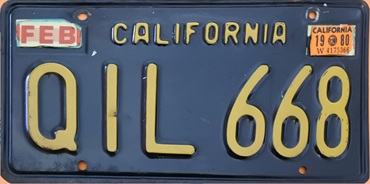
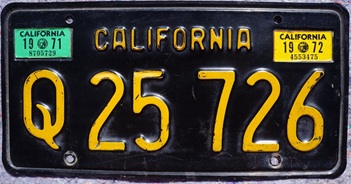
The letter I was a simple vertical line with no serifs. From a distance, if a reader wasn't paying close attention, it could be confused with the numeric digit 1, particularly if the reader was unfamiliar with the look of a 1 on California plates (1's had, and still have, serifs on the top and bottom).
Standard plates issued for passenger cars during this era had license numbers that consisted of 3 letters, followed by a half-space, followed by 3 numeric digits. The first such plate issued would have been AAA 000. The digits were incremented first, then they wrapped back around to zeroes and the letters were incremented, i.e. the plates would've gone AAA 000, AAA 001, AAA 002, ..., AAA 999, then AAB 000, AAB 001, etc..
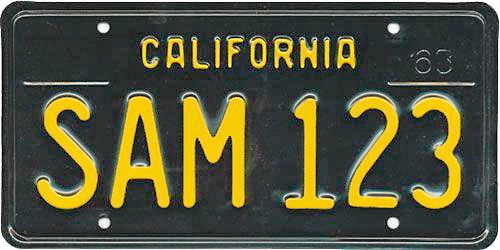
Nominally, this would've yielded 263 times 103, or 17 576 000 possible combinations. However, not all combinations were used. Due to the potential for confusion between the letter I and the number 1, and between the letters O and Q and the number 0, the 3-letter portion of the license number couldn't end with an I, O, or Q. (Unlike the modern era, such license numbers could begin with an I, O, or Q, however.)
Becase all passenger cars were issued a black plate in 1963, this year saw an enormous number of license number combinations being used. Many cars that had been registered in previous years were issued license numbers that ran deep into the alphabet. For example, the author of this page once owned a 1959 Edsel which had doubtlessly been registered in California when it was bought new, yet whose black license plate had the "63" stamp in the upper right corner and read DOU 526.
Here is a list of all passenger plate 3-letter combination ranges distributed to DMV offices in 1963. They were distributed in groups to specific regions:
Fun fact: The Jet Propulsion Laboratory in La Cañada convinced California to have all passenger plates that started with "JPL" shipped to the nearby Pasadena DMV. This allowed the JPL employees there to have a plate with the lab's initials on their cars.
After 1963, more plates were (of course) made whenever the various DMV regions ran out. The year in which each range of passenger plates was made were as follows:
The transition from black plates to blue plates coincided with the exhaustion of these passenger plate license number combinations in 1969.
Standard plates issued for commercial vehicles during this era had license numbers that consisted of one letter, followed by a half-space, followed by 2 numeric digits, followed by another half-space, followed by 3 numeric digits. The first such plate issued would have been A 00 000. As with passenger plates, the digits were incremented first, going right-to-left, and when they wrapped around the letter was incremented, i.e. the plates would've gone A 00 000, A 00 001, A 00 002, ..., A 99 999, then B 00 000, B 00 001, etc..
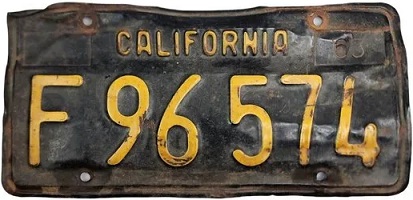
This would yield a maximum of 26 times 105, or 2 600 000 possible combinations, approximately 15% as many possible combinations as there were for passenger plates. I'm guessing that, as with passenger plates, the letter could not be an I or an O due to its potential for confusion with a 1 or a 0, but I have no observations to back that up.
This limited number of combinations actually presented a problem. California could have chosen to use the 2-letters-and-4-digits pattern for commercial plates, which would have resulted in 6 760 000 possible combinations. But California instead chose to use that pattern for trailer plates (as discussed below). My guess is that California probably thought that, because one truck could be used to tow several trailers, there would be more trailers registered in California than there were commercial vehicles. The problem is, California also required all smaller vehicles that typically had commercial uses to get a commercial plate, even if the vehicle wasn't actually intended for commercial use.
Including pickup trucks.
With the explosion in the popularity of pickup trucks as ordinary commuter vehicles, in the 6 years of the black plate era there were far more vehicles registered in California that required commercial plates than there were commercial plate license number combinations available. They ran out of license numbers before this short era was even over.
To stretch the supply of available license number combinations, the order of the characters was subsequently reversed. Rather than a letter followed by 5 digits, the later black commercial plates had 5 digits followed by a letter. As before, the digits were incremented first, followed by incrementing the letter once 99 999 wrapped around to 00 000.
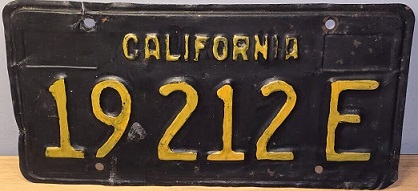
Standard plates issued for trailers during this era had license numbers that consisted of two letters, followed by a half-space, followed by 4 numeric digits. The first such plate issued would have been AA 0000. As with passenger and commercial plates, the digits were incremented first, then when they wrapped back around to zero the letters were incremented, i.e. the plates would have gone AA 0000, AA 0001, AA 0002, ..., AA 9999, then AB 0000, AB 0001, etc..
This would yield a maximum of 262 times 105, or 6 760 000 possible combinations. I'm guessing that, as with passenger plates, the last letter could not be an I, O, or Q due to its potential for confusion with a 1 or a 0, but I have no observations to back that up.
Unlike commercial plates, there were far more possible license number combinations available for trailers than there were trailers registered in California. Perhaps they underestimated the number of trucking companies that would choose to register their trailers in states with lower vehicle taxes.
According to online sources, license numbers starting with UA through YX were reserved for commercial weight fee trailiers (trailers bigger than a certain threshold, which were required to pay a weight fee as part of their registration cost).
"Exempt" license plates are issued to government-owned vehicles, which are exempt from having to pay registration fees and road taxes. During the black license plate era, exempt plates were indicated by an "E" on the left side of the plate inside an octagon or a diamond. Octagons were used for vehicles owned by local governments (cities, counties, etc.), while diamonds were used for vehicles owned by the State of California.
The license numbers for these plates consisted entirely of six numeric digits, displayed to the right of the E-in-the-octagon-or-diamond. No wells for registration stickers were present, because exempt plates didn't need them, of course.
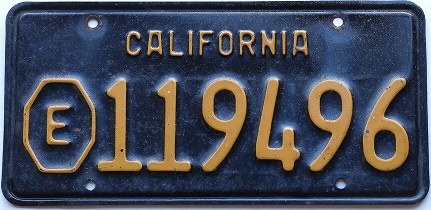

Police car license plate, screen-captured
from the TV series Adam-12
Send comments about this webpage to: rogermw@ix.netcom.com.
Go back to my main license plate index page.
Go back to Roger M. Wilcox's homepage.